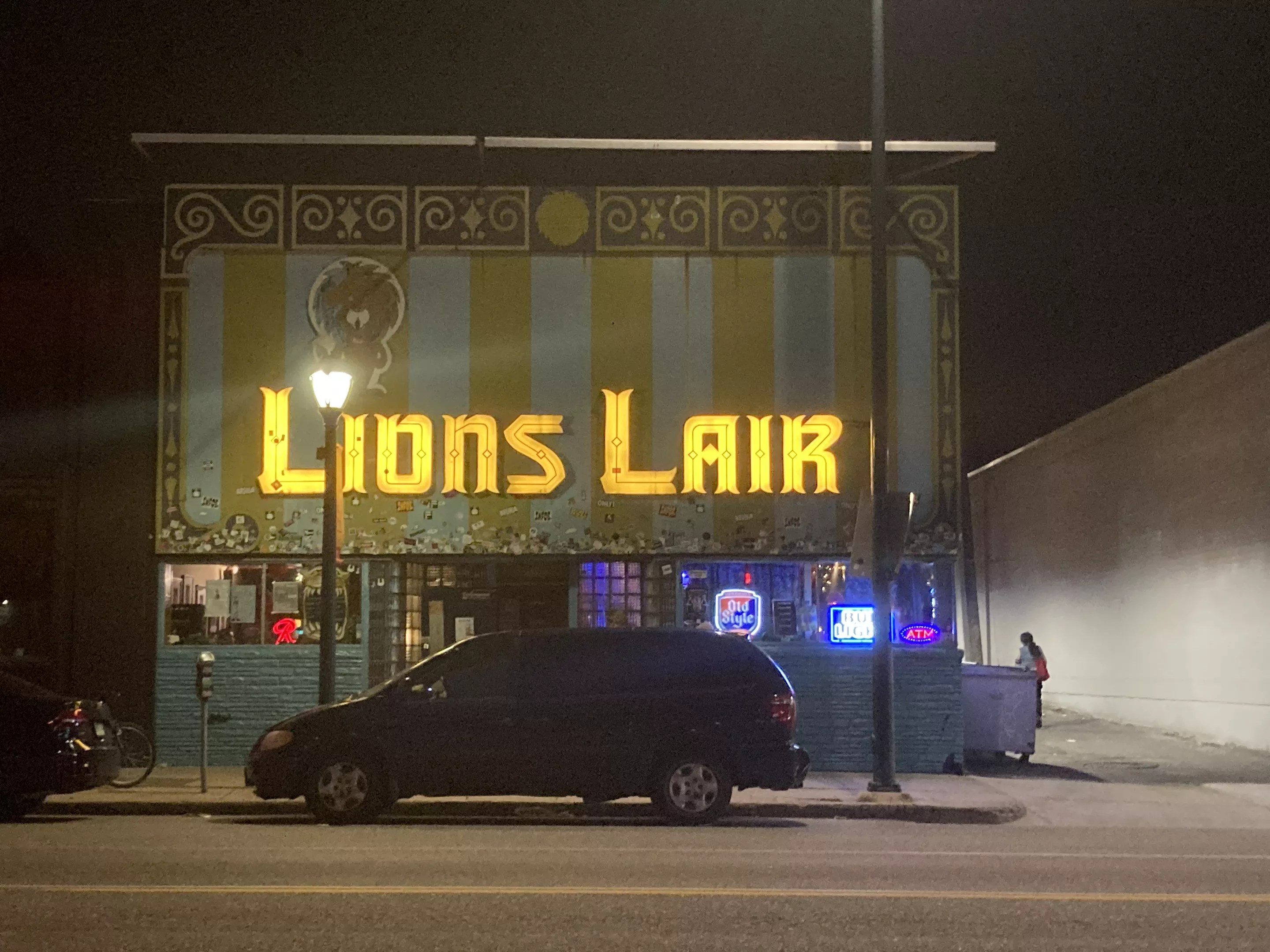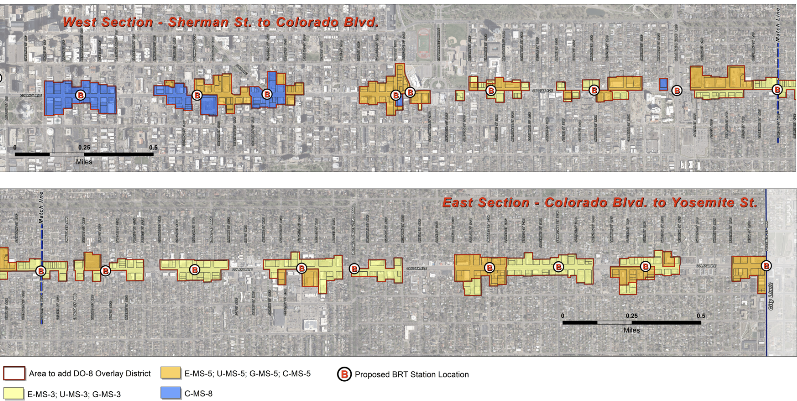
Julianna O’Clair

Audio By Carbonatix
Denver City Council made a major move toward shaping the future of East Colfax Avenue when it unanimously approved a DO-8 overlay for nearly five miles of the historic Denver street this month.
“Colfax is an iconic and historic symbol and street and area of Denver, and this rezoning is a pivotal step toward preserving and enhancing its legacy,” councilmember Amanda Sawyer, who worked with colleague Chris Hinds on the proposal, said at the December 11 council meeting.
A DO-8 overlay is a Denver zoning tool that was developed by councilmember Amanda Sandoval to encourage vibrant development along Tennyson Street, which is in her district. The overlay changes what types of buildings can be constructed, with the goal of providing more sidewalk activation.
According to Hinds, he started thinking about applying the concept to Colfax in 2020, when he learned of plans to construct a self-storage facility at the intersection of Pearl Street and Colfax. At the same time, there was a new bank drive-thru proposed for 14th and Grant streets.
“I said, ‘Hey, what about having a drive-thru on the ground floor but maybe seven stories of affordable housing above it?,” Hinds recalls asking the bank. “‘I’ll bet I could find an affordable housing company that would be willing to build your drive-thru for you for free if you were willing to put in affordable housing.’ And they were not interested.”
After that, Hinds says, he realized that it would take a concerted effort to maintain Colfax’s quirky reputation while also cultivating it as a pedestrian corridor. Along with the planned Bus Rapid Transit (BRT) project that will create a dedicated bus line in the center of the street, this overlay is meant to help achieve that goal.
“It really kind of meshes well with what we heard from our residents for what they want to see,” Sawyer tells Westword. “It meshes well with our economic goals as a city in terms of business development and supporting our small businesses. It meshes well with our transportation goals with the buildout of the Bus Rapid Transit system along Colfax.”
Both councilmembers say they were happy with the result of their years of work, which will rezone the properties along Colfax from Grant to Yosemite streets within two blocks of proposed BRT stations. According to a letter that Libbie Glick, the senior city planner who worked on the project, sent to the Denver Planning Board on October 11, the overlay will cover approximately 600 acres of land and over 400 parcels along Colfax.
The street was already a Main Street Zone under current Denver zoning code, in which four building forms are allowed: shopfront, townhouse, drive-thru services and drive-thru restaurant. Under the new overlay, only the shopfront and townhouse forms are allowed.
The overlay also establishes a minimum two-foot street setback for shopfront buildings, in order to increase pedestrian space, as well as a seven-foot primary street setback for shopfront buildings with ground-floor residential units. Such units also have to have a porch, patio or stoop to help with the transition from public to private.
The overlay requires parking to be in the rear or to the side of buildings, and encourages street-level windows by banning all alternatives to transparency requirements except permanent art. And the ground floor of every lot more than 37.5 feet wide must have non-residential active uses.
“The increased setbacks and the ground-floor activation will really help guide Colfax into that multimodal and community- friendly area that we want to see,” Sawyer explained at the council meeting. “This transformation not only enhances that accessibility, but promotes healthy lifestyles and fosters more connected neighborhoods along the corridor.”
The original idea was to have the overlay apply to the entire stretch between Grant and Yosemite, but during the planning process, the team realized that Colfax isn’t dense enough for the whole area to support such intense sidewalk activation, Hinds says.

A map showing what areas the overlay will apply to.
Denver Community Planning and Development
“This is a compromise with some of the business owners along the corridor, some of the property owners along the corridor, and makes sense,” he adds. “We want to celebrate public transit as best we can, so we can prioritize density and people near the BRT stops. Then it’s a symbiotic relationship, because BRT stops, then become more valuable for people, and people want to use the BRT more because the things that they want to get to are right by the BRT stops.”
Sarah Parady, an at-large councilmember, asked about those gaps during the December 11 meeting. Glick explained that while the team realized the lack of density could not support the zoning in some places, fully residential uses would be a good outcome for some areas, helping alleviate Denver’s lack of housing.
“There’s a real desire to ensure that those businesses are not only there, but those businesses are successful,” Sawyer added. “In order for those businesses to be successful, they need to have that density.”
The other sticky issue that came up at the meeting involved drive-thrus and fast-food spots, which are not actually banned by the overlay but would be limited in terms of how they could be built. The McDonald’s at Pennsylvania and Colfax, for example, almost fits the zoning requirements already: Its drive-thru and parking are behind the building; while it has a customer entrance off Colfax, cars can only enter from Pennsylvania or an alleyway; and it has tall ceilings. If it were to add more ground-level windows facing Colfax, the space would meet all the overlay requirements.
Robin Rothman, who lives just south of Colfax in a zone where the overlay will apply, testified during the December 11 public hearing. “Nationally, businesses like fast-food operators, banks and gas stations have overcome far more onerous requirements than what DO-8 asks for, and the result has health consequences,” she said. “Currently, there are seventeen fast-food restaurants along the five miles of Colfax included in this zoning. Get ready, because number eighteen is coming in the form of a Jack in the Box.”
That Jack in the Box is planned for Williams Street at Colfax, and Rothman went on to describe the negative health impacts of such operations both nutritionally and because of air pollution from idling vehicles. She encouraged council to go further than the planned overlay, noting that the gaps where there isn’t a planned BRT stop would allow operations like the Jack in the Box to do whatever they want.
“When you’re developing an overlay that’s meant to make places vibrant, safe, pedestrian-friendly, healthy, environmentally friendly, a fast-food restaurant just isn’t it,” Rothman tells Westword.
She points to Minneapolis, where drive-thrus have been banned, and proposals in other cities. “Colfax is a destination,” Rothman says. “I love Colfax; that’s why I live near it. But if your vision for Colfax is something that’s vibrant, active, healthy, whatever, why wouldn’t you put better rules in place?”
According to Denver councilmembers, banning drive-thrus altogether is not a goal for this part of Colfax. Sawyer, in particular, doesn’t want the overlay to infringe on private property rights.
“Property rights are a tenet that has been well tested, well established and very well supported within the state of Colorado, and the Western United States of America in particular, for 150 years,” she says. “We’re not going to change that overnight and we don’t want to – but what we can do is we can ensure that if a private property owner comes in and they want to build something like that, they also have to follow these design guidelines.”
That way, property owners still have rights, but the corridor will become more walkable and welcoming.
During the December 11 meeting, Sawyer noted that some people don’t believe the overlay goes far enough, while others think it’s too restrictive. But most fall somewhere in the middle, she added, which is what makes the policy the right choice.
Sawyer also promised that she and Hinds will continue working to prioritize what the community wants on this legendary Denver corridor.
“As councilmembers, we have limited levers we can pull when it comes to how we achieve those goals that we heard from the community that were so important,” Sawyer says. “This is one of those levers. Being able to shape the design of future development along the corridor to achieve the goals that we’re trying to achieve is just one tiny part of a lot of different moving pieces.”